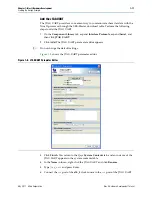
Chapter 1: Nios II Hardware Development
1–3
OpenCore Plus Evaluation
May 2011
Altera Corporation
Nios II Hardware Development Tutorial
You can build the design example in this tutorial with any Altera development board
or your own custom board that meets the following requirements:
■
The board must have an Altera Stratix
®
series, Cyclone
®
series, or Arria
®
series
FPGA.
■
The FPGA must contain a minimum of 2500 logic elements (LE) or adaptive look-
up tables (ALUT).
■
The FPGA must contain a minimum of 50 M4K or M9K memory blocks.
■
An oscillator must drive a constant clock frequency to an FPGA pin. The
maximum frequency limit depends on the speed grade of the FPGA. Frequencies
of 50 MHz or less should work for most boards; higher frequencies might work.
■
FPGA I/O pins can optionally connect to eight or fewer LEDs to provide a visual
indicator of processor activity.
■
The board must have a JTAG connection to the FPGA that provides a
programming interface and communication link to the Nios II system. This
connection can be a dedicated 10-pin JTAG header for an Altera USB-Blaster
™
download cable (revision B or higher) or a USB connection with USB-Blaster
circuitry embedded on the board.
1
To complete this tutorial, you must refer to the documentation for your board that
describes clock frequencies and pinouts. For Altera development boards, you can find
this information in the associated reference manual.
f
For information about Altera development kits and development boards, refer to the
page of the Altera website
.
OpenCore Plus Evaluation
You can perform this tutorial on hardware without a license. With Altera's free
OpenCore Plus evaluation feature, you can perform the following actions:
■
Simulate the behavior of a Nios II processor within your system
■
Verify the functionality of your design
■
Evaluate the size and speed of your design quickly and easily
■
Generate time-limited device programming files for designs that include Nios II
processors
■
Program a device and verify your design in hardware
You need to purchase a license for the Nios II processor only when you are completely
satisfied with its functionality and performance, and want to use your design in
production.
f
For more information about OpenCore Plus, refer to
.








































